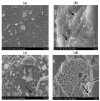Lipase Immobilization on Silica Xerogel Treated with Protic Ionic Liquid and its Application in Biodiesel Production from Different Oils
- PMID: 29933608
- PMCID: PMC6073416
- DOI: 10.3390/ijms19071829
Lipase Immobilization on Silica Xerogel Treated with Protic Ionic Liquid and its Application in Biodiesel Production from Different Oils
Abstract
Treated silica xerogel with protic ionic liquid (PIL) and bifunctional agents (glutaraldehyde and epichlorohydrin) is a novel support strategy used in the effective immobilization of lipase from Burkholderia cepacia (LBC) by covalent binding. As biocatalysts with the highest activity recovery yields, LBC immobilized by covalent binding with epichlorohydrin without (203%) and with PIL (250%), was assessed by the following the hydrolysis reaction of olive oil and characterized biochemically (Michaelis⁻Menten constant, optimum pH and temperature, and operational stability). Further, the potential transesterification activity for three substrates: sunflower, soybean, and colza oils, was also determined, achieving a conversion of ethyl esters between 70 and 98%. The supports and the immobilized lipase systems were characterized using Fourier transform infrared spectra (FTIR), scanning electron microscopy (SEM), elemental analysis, and thermogravimetric (TG) analysis.
Keywords: hydrolysis; immobilization; lipase; protic ionic liquid; transesterification; treated silica xerogel support.
Conflict of interest statement
The authors declare no conflict of interest.
Figures








References
-
- Lin Y.C., Yang P.M., Chen S.C., Lin J.F. Improving biodiesel yields from waste cooking oil using ionic liquids as catalysts with a microwave heating system. Fuel Process. Technol. 2013;115:57–62. doi: 10.1016/j.fuproc.2013.04.004. - DOI
-
- Zheng M., Xiang X., Wang S., Shi J., Deng Q., Huang F., Cong R. Lipase immobilized in ordered mesoporous silica: A powerful biocatalyst for ultrafast kinetic resolution of racemic secondary alcohols. Process Biochem. 2017;53:102–108. doi: 10.1016/j.procbio.2016.12.005. - DOI
MeSH terms
Substances
LinkOut - more resources
Full Text Sources
Other Literature Sources
Research Materials
Miscellaneous

